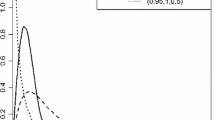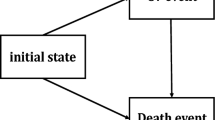Abstract
In this paper, we present a shared frailty model for gap time distributions of recurrent event data with competing risks based on weighted risk-set method. The parameters of the model are estimated using the EM algorithm. A simulation study is carried out to assess the performance of the proposed estimators. An application of proposed model is illustrated using a real life data set.




Similar content being viewed by others
References
Andersen P, Gill R (1982) Cox’s regression model for counting processes: a large sample study. Ann Stat 10(4):1100–1120
Andersen PK, Borgan O, Gill RD, Keiding N (2012) Statistical models based on counting processes. Springer Science & Business Media, New York
Balakrishnan N, Peng Y (2006) Generalized gamma frailty model. Stat Med 25(16):2797–2816
Brown PM, Ezekowitz JA (2019) Frailty modelling for multitype recurrent events in clinical trials. Stat Model 19(2):140–156
Byar D (1980) The veterans administration study of chemoprophylaxis for recurrent stage I bladder tumours: comparisons of placebo, pyridoxine and topical thiotepa. In: Bladder Tumors and Other Topics in Urological Oncology. Springer, New York
Cook RJ, Lawless J (2007) The statistical analysis of recurrent events. Springer Science & Business Media, New York
Dabrowska DM, Sun G-W, Horowitz MM (1994) Cox regression in a markov renewal model: an application to the analysis of bone marrow transplant data. J Am Stat Assoc 89(427):867–877
Duchateau L, Janssen P, Kezic I, Fortpied C (2003) Evolution of recurrent asthma event rate over time in frailty models. J R Stat Soc Ser C (Appl Stat) 52(3):355–363
Gail M, Santner T, Brown C (1980) An analysis of comparative carcinogenesis experiments based on multiple times to tumor. Biometrics 36(2):255–266
Hougaard P (2012) Analysis of multivariate survival data. Springer Science & Business Media, New York
Huang C-Y, Wang M-C (2005) Nonparametric estimation of the bivariate recurrence time distribution. Biometrics 61(2):392–402
Lawless JF, Nadeau C (1995) Some simple robust methods for the analysis of recurrent events. Technometrics 37(2):158–168
Lee J, Cook RJ (2019) Dependence modeling for multi-type recurrent events via copulas. Stat Med 38(21):4066–4082
Lin D, Sun W, Ying Z (1999) Nonparametric estimation of the gap time distribution for serial events with censored data. Biometrika 86(1):59–70
Lin DY, Wei L-J, Yang I, Ying Z (2000) Semiparametric regression for the mean and rate functions of recurrent events. J R Stat Soc Ser B (Stat Methodol) 62(4):711–730
Liu L, Wolfe RA, Huang X (2004) Shared frailty models for recurrent events and a terminal event. Biometrics 60(3):747–756
Luo X, Huang C-Y (2011) Analysis of recurrent gap time data using the weighted risk-set method and the modified within-cluster resampling method. Stat Med 30(4):301–311
Manda SO, Meyer R (2005) Bayesian inference for recurrent events data using time-dependent frailty. Stat Med 24(8):1263–1274
McGilchrist C, Yau K (1996) Survival analysis with time dependent frailty using a longitudinal model. Aust J Stat 38(1):53–60
Murphy SA (1995) Asymptotic theory for the frailty model. Ann Stat 23(1):182–198
Parner E (1998) Asymptotic theory for the correlated gamma-frailty model. Ann Stat 26(1):183–214
Pepe MS, Cai J (1993) Some graphical displays and marginal regression analyses for recurrent failure times and time dependent covariates. J Am Stat Assoc 88(423):811–820
Ripatti S, Palmgren J (2000) Estimation of multivariate frailty models using penalized partial likelihood. Biometrics 56(4):1016–1022
Sankaran P, Anisha P (2011) Shared frailty model for recurrent event data with multiple causes. J Appl Stat 38(12):2859–2868
Vaupel JW, Manton KG, Stallard E (1979) The impact of heterogeneity in individual frailty on the dynamics of mortality. Demography 16(3):439–454
Wang M-C, Chang S-H (1999) Nonparametric estimation of a recurrent survival function. J Am Stat Assoc 94(445):146–153
Wang M-C, Qin J, Chiang C-T (2001) Analyzing recurrent event data with informative censoring. J Am Stat Assoc 96(455):1057–1065
Wang W, Wells MT (1998) Nonparametric estimation of successive duration times under dependent censoring. Biometrika 85(3):561–572
Wei L-J, Lin DY, Weissfeld L (1989) Regression analysis of multivariate incomplete failure time data by modeling marginal distributions. J Am Stat Assoc 84(408):1065–1073
Yau K, McGilchrist C (1998) Ml and reml estimation in survival analysis with time dependent correlated frailty. Stat Med 17(11):1201–1213
Ye Y, Kalbfleisch JD, Schaubel DE (2007) Semiparametric analysis of correlated recurrent and terminal events. Biometrics 63(1):78–87
Acknowledgements
The authors are grateful to the referees and editor for their constructive comments. The second author thanks INSPIRE, the Department of Science and Technology, Government of India for providing financial support.
Funding
The first author thanks KSCSTE, the Government of Kerala for providing financial support. The second author thanks INSPIRE, the Department of Science and Technology, Government of India for providing financial support. The corresponding DST INSPIRE registration number IF160801.
Author information
Authors and Affiliations
Corresponding author
Ethics declarations
Conflict of interest
On behalf of all authors, the corresponding author states that there is no conflict of interest.
Additional information
Publisher's Note
Springer Nature remains neutral with regard to jurisdictional claims in published maps and institutional affiliations.
Rights and permissions
About this article
Cite this article
Sankaran, P.G., Sisuma, M.S. Shared Frailty Model for Recurrent Event Competing Risks Data Using Averaged Counting Process Approach. J Indian Soc Probab Stat 23, 227–239 (2022). https://doi.org/10.1007/s41096-022-00124-7
Accepted:
Published:
Issue Date:
DOI: https://doi.org/10.1007/s41096-022-00124-7




